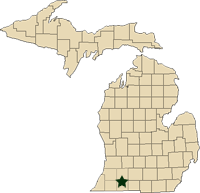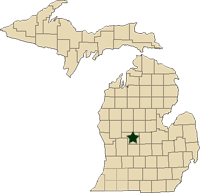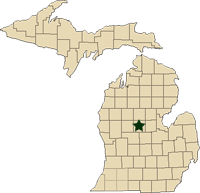Regional reports on Michigan field crops – June 14, 2012
MSU Extension educators’ pest and field crop updates for Michigan.
This week’s regional reports:
- Southwest Michigan – Bruce Mackellar
- West Central Michigan – Fred Springborn
- Central Michigan – Paul Gross
Southwest Michigan – Bruce Mackellar, Michigan State University Extension
|
Weather
Hot conditions over the weekend have spurred on corn and soybean growth to an almost frenetic pace. Isolated thunderstorms brought some relief to dry conditions to portions of extreme southeast Cass and St. Joseph counties on Monday evening (June 11), but most areas did not receive more than 1/10 of an inch to the north and west. Cooler temperatures after the passage of the cold front have reduced moisture stress, but a steady wind and brilliant sunshine has taken away some of that advantage.
Rainfall
Precipitation totals since May 1 average 2.76 inches across the 13 Enviro-weather stations in the southwestern portion of the state. That is around 1.5 inches behind normal, but there are large variations between locations. The Lawton, Mich., area has only received 1.64 inches while the Benton Harbor, Mich., area received 3.78. Above normal precipitation is indicated in the 6 to 10 day outlook from NOAA, and normal precipitation conditions are anticipated in the 8 to 14 day outlook.
Temperature
Southwest Michigan is expected to have above normal temperatures in the 6 to 10 day outlook, with a moderating trend for the 8 to 14 day period to more normal temperatures. Base 50 GDDs averaged 610 GDDs base 50 since May 1. We normally accumulate around 17 GDDs base 50 during the next five-day period. Warmer temperatures in the forecast will continue to push that number ahead.
Crops
Early planted corn is at V6 to V7. Moisture stress is becoming more evident on the larger corn across the region. Many fields with irrigation systems have been running water to try to stay ahead of the depletion curve. Sidedress nitrogen operations are continuing as fast as growers can get material applied. Later planted fields are V4 to V5. For those planning on using glyphosate to clean up late season weeds, remember that the window of broadcast application to corn is up to 30 inches or V8 corn. You can apply later with drops.
I continue to find areas where there are armyworms in light numbers in corn fields. The moth flight has been spread out, so some of the later larvae are continuing to feed. All have been way below threshold numbers in the fields I have walked, but still warrants monitoring, particularly on late planted corn. Watch for "wavy" leaf edge feeding. There continue to be reports of Asiatic garden beetle white grub feeding damage, this time in Cass and St. Joseph counties. Watch weed growth development in later planted fields and consider early post-herbicide applications where moisture stress could be damaging to the crop.
Early planted soybeans are at the third trifoliate stage. Bean leaf beetle feeding is present. I have not seen soybean aphids at this point. Herbicide application timing may be crucial to reduce stress as soils are very dry and high temperaturse are expected over the weekend. Weeds are growing fast. Also be sure to add AMS to your sprayer before adding the glyphosate when making roundup applications to roundup-ready soybeans.
Conditions are right for the initial appearance of spider mites. Spider mites love hot, dry and dusty conditions. These are sort of "sleeper" pests because we usually do not find damage until the numbers are pretty high. Watch for yellowing or bronzing of leaves in areas of the field that are adjacent to gravel roads or farm lanes. Dust tends to keep pathogenic fungi at bay, so these areas tend to be the first to develop populations. Spider mites are only 1/50 of an inch long, so you cannot directly see the pests, only the symptoms of their feeding damage. They can move from place to place by spinning a "sailing web" and riding the air current to another location in the field or adjacent fields.
Wheat is beginning to turn fairly quickly in more advanced fields. Moisture stress may be playing a role in this. If you a planning on trying to raise second crop soybeans, keep in mind that that planting in the end of June or the first few days in July has a significant advantage over beans planted the second week of July.
Regarding alfalfa, potato leafhopper numbers are on the rise around the area. Keep an eye on alfalfa regrowth. Threshold is one potato leafhopper adult per sweep in the early regrowth stage. Hot, dry conditions are nearly perfect for the rapid increase of this pest in fields.
West Central Michigan – Fred Springborn, Michigan State University Extension
|
Weather
Dry weather was experienced over much of the central region this week. High air temperatures ranged from the upper 70s to mid-80s at Entrican, Mich. Low air temperatures were in the mid-40s to mid-60s. Low soil temperatures at 2 inches are in the mid-60s.
Crops
Wheat is just starting to turn in advanced fields. Lighter soils in many unirrigated wheat fields are showing signs of moisture stress.
Corn ranges from V2 to V9 with much of the crop between V4 and V8. Larger corn is showing moisture stress on lighter soils. Sidedressing is continuing, as well as post-emergence herbicide applications.
Reports of armyworms are still coming in, but they are very scattered in the west central region. The majority of the region has not seen widespread damage. Where we have seen larvae, they are mostly quite large between 0.75 and 1 inch. Keep in mind that large armyworm larvae (1.5 inches long) are difficult to kill with insecticides and will likely pupate soon. Also watch preharvest intervals if making an insecticide application to wheat.
Alfalfa first cutting is by in large done. Second cutting ranges from early regrowth to bud stage, depending on timing of first cutting. Potato leafhopper numbers are not large but need to be monitored.
Dry bean planting is approximately 45 percent complete in Montcalm and Mecosta, Mich., with significant progress occurring daily. Germination and emergence has been rapid in most cases.
Central Michigan – Paul Gross, Michigan State University Extension
|
Weather
Parts of the region received about 0.25 inches of rain early Monday morning (June 11), bringing some relief to generally dry conditions. The cooler temperatures over the past week have not been ideal for crop growth, but have kept crop stress to a minimum because of the dry conditions. Crops are showing some moisture stress on the lighter soils. Rain will be needed soon for crops that have gotten off to a good start this season.
Commodity reports
The corn crop is progressing but is in need of rain. The crop ranges from V3 to V7. Nitrogen applications are being made. Nitrate tests are reported to be good this year. There are high populations of armyworms in some areas. Farmers are advised to scout fields for this pest. Focus on fields next to fence rows, ditches and grass hay fields. When caught early, border applications of insecticide will control this pest.
Soybeans are progressing with several reports of stand and emergence problems. Some of the stand problems are associated with dry soil conditions and some to hard rains and crusting after planting. There are a number of fields or parts of fields that have been replanted. There are reports of armyworm feeding in soybeans this year. Farmers are advised not to wait too long for the first herbicide applications. Early season weed pressure can reduce soybean yields.
The wheat crop is beginning to turn. We are seeing a number of fields that are being attacked by armyworms. There are reports of head clipping. Scout fields immediately for this pest. Many of the foliar diseases are still infecting the crop. It appears that harvest will begin in early July.
Harvest of second cutting alfalfa is well underway. The early reports are that yields are very good. Many of the fields that were injured by the frost this spring have recovered nicely. It is advised to let the second cutting mature to early flower before cutting. While this will lower quality, it will provide the alfalfa plant an opportunity to replenish carbohydrates in the roots. This will benefit the stand long term. Potato leafhopper populations are building. Scout for this pest.
Oats and barley are headed. Early indications are that the yields will be very good.
Dry bean planting is wrapping up. There have been some challenges with emergence in some areas. Overall the crop looks good.
Sugarbeets are outstanding at this point in the growing season. Many are reporting that the crop is off to the best start they can remember. No real problems are being reported.



 Print
Print Email
Email





